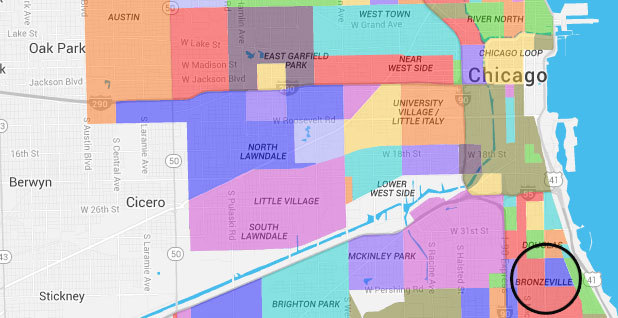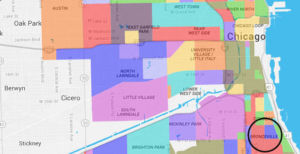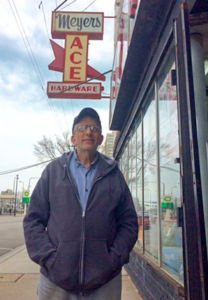Being from Chicago myself, (actually, Highland Park) I find this article to be of special interest. And since so many of the people who get this blog are also from this area, I figured that it would also be worth sending it around. Besides, the project is designed to be a model for the rest of the country.
Historic Chicago Neighborhood Points Way to Energy’s Future
Daniel Cusick, E&E reporter
Monday, June 6, 2016
map of Bronzeville neighborhood in Chicago
[+] Bronzeville is a historic district in the Douglas community area of the South Side of Chicago. Map by Kevin Zolkiewicz, courtesy of Chicago Maps.
CHICAGO — Little says “high tech” about Bronzeville, one of this city’s South Side neighborhoods where vacant lots and boarded-up buildings beg for attention even as new luxury condos and office towers rise a few miles to the north.
But Bronzeville, a roughly 2-square-mile area of 40,000 people wedged between the rejuvenated South Loop and Hyde Park, home of the Obamas, represents much more than another Chicago neighborhood swimming against the economic tide.
Commonwealth Edison, the 110-year-old utility that powers this city and much of northern Illinois, plans to make the largely African-American neighborhood its first “Community of the Future,” a place where advanced power generation and delivery meet one of the nation’s largest and most complex urban landscapes.
For ComEd, the investment is more than a good will gesture to a historic community. It represents a critical early test for how one of the nation’s largest utilities will operate in a rapidly changing world — one where the grid is no longer a one-way street carrying electrons to consumers, but a multidirectional network, or “platform,” for the exchange of power, information and other services.
If successful, utility officials say, the “smart grid” will make power more affordable, accessible and reliable for a broad cross-section of energy consumers, from Fortune 500 firms and affluent suburbanites to inner-city residents and storefront businesses like Jimmy’s Food & Deli here on East 35th Street and South Prairie Avenue.
On a recent weekday, Sam Altawil was ringing up the morning regulars at Jimmy’s, where he is a clerk and purveyor of neighborhood news and gossip. The store has made headlines before. A year ago, Jimmy’s was the backdrop of a corner gunfire exchange between rival groups, leaving four wounded and one innocent bystander dead just outside the store.
On this morning, the talk was all about the surprising death of Prince, the pop star who electrified the world with his music, art and enigmatic persona. So when asked about ComEd’s grid blueprint for Bronzeville, Altawil smiled and shrugged.
“Never heard of it, but I’m for it if it helps the neighborhood,” he said, noting that Bronzeville lacks many of the basic amenities that other Chicago neighborhoods enjoy, like a Wal-Mart or Target.
David Meyers
“I spend 10 hours a day in here, and I’ve never heard a customer talk about the grid,” said hardware store owner David Meyers. Photo by Daniel Cusick.
Like many Chicagoans, Altawil said he knows ComEd as the company that keeps Jimmy’s lights on, its coolers cold and its cash register humming. But the terms “smart grid” and “microgrid” mean almost nothing in a place where electric reliability boils down to a simple equation: lights on, lights off.
Altawil isn’t alone. Few people here appear to be familiar with Bronzeville’s status as the “Community of the Future,” even after the utility hosted a public rollout event in February featuring top executives, elected officials and community leaders.
“I spend 10 hours a day in here, and I’ve never heard a customer talk about the grid,” said David Meyers, the third-generation owner of Meyers Ace Hardware, which opened in Bronzeville in 1921 and remains an anchor business in the community.
Asked whether he thought a $50 million grid improvement project could improve living conditions in Bronzeville, Meyers demurred.
“I’m not much for telling other people what they should do with their money. What we really need around here is jobs.”
Yet such indifference stands in contrast to the messages coming from city and utility leaders.
Anne Pramaggiore, ComEd’s president and CEO, has said Bronzeville would provide a “foundation to build the clean-energy future we all want” and is “a way to tailor the grid so that it’s customized and community-based, more dynamic and capable of solving specific customer needs at the community level” (see related story).
Alderman Pat Dowell, whose 3rd Ward encompasses Bronzeville, said the multimillion-dollar ComEd initiative would help place the community “on the verge of a new and exciting renaissance, poised to emerge as an epicenter of innovation.”
The transformation, officials say, is already underway, even if it hasn’t captured the neighborhood’s imagination.
In the land of ‘Windsanity,’ a microgrid
For example, several thousand smart meters are now spinning in the backyards and basements of homes and businesses here, providing the neurons of what ComEd says will be a more robust, efficient and nimble power system for the community.
Among other things, the meters’ ability to tailor electricity supply and demand in real time using digital communications will help customers use power more efficiently, while also helping ComEd respond quickly to weather emergencies, accidental outages, power surges and other grid disruptions.
ComEd is also investing heavily in “smart switches” that automatically reroute power along distribution lines to bypass unplanned outages and bottlenecks that put whole neighborhoods at risk of grid failure.
And perhaps most significantly, ComEd plans to deploy in Bronzeville the first utility-owned microgrid in the United States — effectively allowing the community to “island” itself from the broader power grid and produce its own electricity for residents, businesses, schools and institutions.
Up to 10 megawatts of generation capacity could be built into the Bronzeville microgrid, officials say, using a mix of distributed resources. These include solar panels, gas turbines, fuel cells, battery storage, and combined heat and power, according to ComEd officials. During a grid emergency, those resources would be tapped to keep Bronzeville’s electricity flowing, even if surrounding neighborhoods go dark.
Extensive power outages are more common here than many outsiders realize, often triggered by wind, rain, snow and other harsh conditions that burnish Chicago’s reputation as the Windy City.
Last February, on an otherwise sunny day, a low-pressure system tracking across the region yielded 60 degree temperatures and 70 mph winds, snapping trees and utility poles and plunging more than 100,000 ComEd customers into the dark. The event, dubbed “Windsanity” by a Chicago blogger, proved that the city’s grid remains vulnerable five years after the utility reached a modern nadir in grid reliability and performance.
A neighborhood rebirth
In the annals of Chicago weather, no year stacks up like 2011. That’s when an early February blizzard — remembered by many for its fierce lightning, thunder and hail — dumped nearly 2 feet of snow on O’Hare International Airport while winds howled to more than 50 mph. ComEd customer outages soared into the hundreds of thousands.
Yet that was just the beginning. In June and July, a series of mega-thunderstorms, cooked by high pressure and summer heat, again brought Chicago’s grid to its knees, hobbling roughly 2 million customers and costing the region billions of dollars in lost infrastructure and broader economic damage.
In a 2012 report to the Illinois Commerce Commission, ComEd called 2011 its worst storm year on record and promised to take steps to harden its grid against outages, including through the execution of a $2.6 billion state-backed program that came to be called the “Smart Grid Law.”
That effort is still being implemented across much of ComEd’s service territory, which extends to more than 11,000 square miles and encompasses some of the wealthiest communities in America. But it has taken on an immediacy in inner-city communities like Bronzeville, which soon will be equipped with the Cadillac of grid technologies, officials say, even if the rest of the neighborhood is still waiting for its 100,000-mile tuneup.
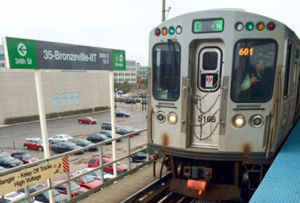 35th Street-Bronzeville-ITT transit station
35th Street-Bronzeville-ITT transit station
The Chicago Transit Authority’s 35th Street-Bronzeville-ITT transit station marks Bronzeville’s border with the Illinois Institute of Technology and neighborhoods to the west. Photo by Daniel Cusick.
From the Chicago Transit Authority L train platform on its western flank, Bronzeville has a distinctly flatter horizon than the downtown skyline just 3 miles to the north. Mid-rise offices and commercial buildings are interspersed with single-family homes, low-rent apartments, fast-food restaurants, and an assemblage of local shops and businesses.
But there is evidence of rebirth here, too. Tulips spring up from random stoop gardens, and the hum of lawn mowers breaks the April morning quiet along South Martin Luther King Jr. Drive, the neighborhood’s main north-south thoroughfare.
The area is also seeing an influx of new urbanites who are buying and rehabilitating Bronzeville’s faded greystones, arguably some of the finest historic homes to be had in Chicago for less than a half-million dollars. Energy and money also flow into the neighborhood from nearby U.S. Cellular Field, home of the South Side’s beloved White Sox.
Bronzeville also has a handful of what ComEd considers critical load sites. They include the headquarters of the Chicago Police and Chicago Fire departments, the Illinois College of Optometry, and Mercy Hospital and Medical Center on its northern edge.
“We’ve tried to wrap an envelope around a pretty good cross-section of the community,” Joe Svachula, ComEd’s vice president for engineering and smart grid, said during a recent interview at the utility’s South Loop offices. “It includes some critical power like police and hospitals, but it also has a lot of housing, and it includes a variety of income levels and other demographic diversity. It’s just a great cross-section of the city.”
Learning from the microgrid next door
When it comes to electricity innovation, Bronzeville also claims a distinct advantage over other city locations because it adjoins one of the world’s leading smart grid research centers, the Illinois Institute of Technology.
The 8,000-student university, through its Robert W. Galvin Center for Electricity Innovation, already operates an advanced microgrid — a 9-MW system completed in 2013 that has the capacity to power the entire campus without a single watt from ComEd.
The IIT microgrid’s chief architect, professor of electrical engineering Mohammad Shahidehpour, is one of the nation’s leading experts on grid innovation and a partner, along with his Galvin Center colleagues, to ComEd as the utility seeks to develop what will effectively be the microgrid next door.
Shahidehpour said designs call for the campus and Bronzeville microgrids to interact with each other via a “master controller” being developed by ComEd, Illinois Tech and other research partners with $1.2 million in research support from the Department of Energy.
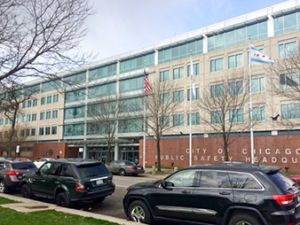 City of Chicago Public Safety Headquarters Building
City of Chicago Public Safety Headquarters Building
Chicago’s Public Safety Headquarters Building, one of a handful of critical load sites in the Bronzeville community on Chicago’s South Side. Photo by Daniel Cusick.
Under normal conditions the microgrids will operate independently from one another, he said. “But if there are extreme events here in Chicago, the two microgrids will be islanded, and they will be tied to a 4-kilovolt underground cable.
“If they need more power on their side of the fence in an emergency, we should be able to deliver it to them instantaneously,” he added.
In January, DOE increased its investment in the ComEd microgrid project via a $4 million grant aimed at developing the Bronzeville’s solar and energy storage capacities. Officials say solar arrays and battery storage are critical to ComEd’s microgrid design because “islandable” distributed energy is what powers the microgrid when no other sources of energy are available.
ComEd, which has a mixed record of support for solar development, now says it welcomes the idea of building large amounts of distributed energy within its footprint, so long as it’s done in a way that maintains the utility’s ability to manage the flow of electricity to customers.
“We’re trying to make sure all of our stakeholders are served,” Svachula said. “We want community solar and rooftop solar to grow in this state, but we’re trying to do it the right way. We want to get the cost issue addressed up front.”
‘Does it help people pay less for energy?’
But considerable hurdles remain. In the state capital of Springfield, where Illinois electricity policy is written, some lawmakers and consumer advocates view ComEd and its parent company, Exelon Corp., as profit machines whose initiatives do not always align with customers’ needs and interests.
For example, the utility’s recent proposal to impose a new “grid access charge” on residential customers drew fire from consumer advocates and a rebuke from Illinois Attorney General Lisa Madigan (D). She told the publication Utility Dive that “ComEd’s untested proposal would take away control and predictability in consumers’ bills and should be rejected.”
Yet for ComEd to realize much of its smart grid vision, including the deployment of microgrids, officials say the utility needs key legislative reforms that allow it to earn a return on its efficiency investments. Under current law, ComEd is not allowed to include energy efficiency projects in its rate base and cannot recoup such costs from customers.
ComEd also has asked the Legislature to change Illinois’ nearly 30-year-old Customer Choice and Rate Relief Act, which prohibits power providers from owning generation assets. Without such a change, officials say they cannot build new solar capacity or other distributed energy resources within microgrid areas like Bronzeville.
Svachula said he understands that some lawmakers and regulators are reluctant to cede more control and more money to ComEd, which in 2014 was ordered by the Illinois courts to refund customers $46 million in rate hikes, including $9 million in surcharges used to finance a smart grid pilot program in the Chicago area.
 Patricia Abrams, executive director of the Renaissance Collaborative, a nonprofit committed to social and economic development in Bronzeville.
Patricia Abrams, executive director of the Renaissance Collaborative, a nonprofit committed to social and economic development in Bronzeville.
Photo by Daniel Cusick.
But he said the Bronzeville project “puts a lot of commitments on us” that have to be met before ComEd receives a penny of its investment. Moreover, he said, the microgrid initiative is projected to actually reduce customers’ rates over the first two years and will be rate-neutral over 10 years.
ComEd also faces an uphill climb selling the virtues of the smart grid locally, especially in a place like Bronzeville, where residents are wary of large institutions.
Patricia Abrams, executive director of the Renaissance Collaborative, a nonprofit providing assistance to Bronzeville’s poor, elderly and homeless, said she welcomes ComEd’s commitment to the neighborhood, but she remains dubious about the benefits that a microgrid will bring to local residents.
“How do we even begin to tell people about the benefit of having a community grid when most of our residents don’t know what the grid is?” Abrams asked. “When you reach a certain economic range, these are the kinds of things people just don’t think about.”
In meetings she has attended with ComEd officials, Abrams said executives acknowledge that while “they’ve got the technology piece down, they don’t have the social piece.” And unless ComEd can provide a meaningful social benefit to Bronzeville — such as jobs, education or worker training — Abrams believes much of the community will remain indifferent about the “Community of the Future.”
“My position on the smart grid comes down to one question: Does it help people pay less for energy?” Abrams said. “Because I know who eventually bears the costs of these kinds of projects. It’s not ComEd. It’s the ratepayers.”
Email: cusick@eenews.net

